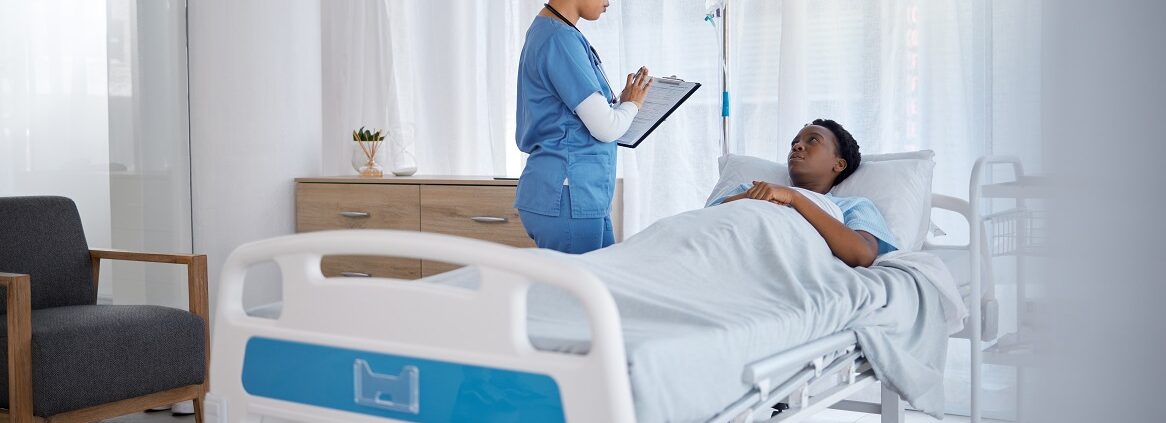Ensuring Patient Health During and After Hospitalization

According to WHO, annually there are about 421 million hospitalizations. The adverse events count is around 42.7 million. Based on conservative estimates, the 14th leading cause of morbidity and mortality is patient harm. It naturally flows that there is widespread concern about patient health and safety during and after hospitalization.
The chance of a patient suffering harm during health care is 1 in 300. To put that in context, the chance of harm to a person traveling in a plane is 1 in a million. The risk is significantly higher for patients. Because of the high risk, frequent and detailed discussions on best practices for ensuring patient health during and after hospitalization are necessary. A few best practices for the same are mentioned below:
During Hospitalization
- Use of Touchless Biometric Identification: With touchless biometric identification, hospitals can significantly reduce the risk of errors and misidentifications. The patient health records will be complete and accurate. It will be easier to preserve the integrity of data. Using touchless biometric identification will help minimize the risk of patient mix-ups and wrong treatments.
- Monitoring and Communication with Healthcare Staff: Being hospitalized puts a person in a very vulnerable position. Various clinicians might attend to the patient. The patient might struggle to get a holistic picture of actual health status. There needs to be sufficient two-way communication with the healthcare staff. Through such communication the patient will also have a better idea about the main issues, ancillary issues, and line of treatment and the staff will also get timely updates from the patient. Clear and adequate communication can help ensure proper comprehension on both sides and prevent many complications.
-
- Infection Prevention and Control Measures: The most common complication during hospitalization is healthcare-associated infection. Every hospital program needs to include standard precautions to prevent infections. Infection prevention and control measures significantly help reduce antibiotic resistance.
- Patient Engagement in the Care Plan: Collaborative care planning can help drive better health outcomes for patients. Continuous dialogue will ensure proper tailoring of the care plan to suit the changing needs of the patient and the removal of potential barriers to care. When goals and care interventions are set after consulting the patients, they also tend to feel more motivated and committed to the plan. Healthcare providers also have better insights because of patient participation and collaboration.
- Taking Care of the Mental Health of the Patient: The frequency and length of hospitalization affect the psychological state of a patient. Frequent and long hospitalization is associated with higher levels of stress, anxiety, and depression. Patients might do better with psychological support and counseling services during and after hospitalization.
- Utilization of checklists: Checklists can prove useful for avoiding mixups and ensuring that nothing is overlooked during surgical rounds and treatment procedures. WHO devised a checklist for surgical safety and tried it in hospitals in eight countries in 2010. This brief but comprehensive checklist helped reduce the site mortality rate (inpatient deaths) from 1.5% to 0.8% and the surgical complications rate from 11% to 7%. Healthcare providers should implement the use of such checklists in their everyday practice.
Smooth Transition and Post-Hospitalization Care
Discharge planning and patient education need careful consideration. It is not just important to ensure that patients leave the hospital in a healthier state, it is equally vital to ensure that the transition back home is smooth and that the patient receives proper care post-hospitalization. It is important to improve hospital-to-home transitions on a systemic level.
Healthcare staff should make the best efforts to look after patient convenience and satisfaction even at the time of discharge. They must provide patients with extensive and clear home care instructions and support resources. Follow-up appointments and medication need to be clearly communicated. Both the patients and hospitals must do their part to prevent gaps in treatment. Patient care after hospitalization is very crucial.
Continued medical attention is essential for a reasonable period (case-by-case basis) post-hospitalization. By carefully monitoring the recovery progress, healthcare providers will be able to recognize signs of complications in time (if any) and take suitable action. A holistic and patient-centered approach can help improve outcomes for patients, reduce the risk of complications, and minimize the likelihood of readmissions. Reduced healthcare cost is an additional benefit.
Medication adherence is important on the part of the patient. The family or care providers of the patient must ensure that the patient makes it to the appointments. Patients also need to make healthy lifestyle choices. Patients can work on their health and fitness with home bodyweight workouts. It is important for patients to consult doctors before starting a fitness routine post-hospitalization. Lifestyle modification and preventive measures will help optimize recovery. An evidence-based regime will contribute to a speedy recovery.
Patients should be actively involved in managing their health in the recovery process. They should build strong support networks that can provide the necessary assistance post-hospitalization and throughout recovery. It is paramount for patients who have undergone transplants or other surgeries to have access to skilled home health care.
Healthcare policies also play an important role in the development and implementation of measures that will lead to efficient patient-centered healthcare.
Conclusion
To ensure patient health and quality care during and after hospitalization, healthcare providers need to coordinate and collaborate with other providers and engage the patients. Efficient and proper care during and after hospitalization can help patients completely recover physically as well as mentally and resume their normal routines or move on to better routines.





Leave a Reply
Want to join the discussion?Feel free to contribute!